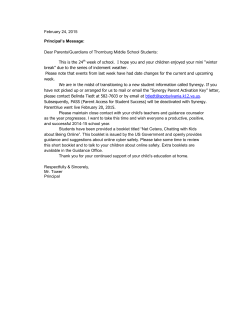
"Collaboration, Partnership, and Student Success
homepage [From the President] By Diana G. Oblinger Collaboration, Partnership, and Student Success C ollaboration and partnership are terms we use often in higher education. We believe that working together is the right thing to do. It is mutually beneficial and mutually reinforcing. In “Innovating Together: Collaboration as a Driving Force to Improve Student Success,” Bridget Burns, Michael M. Crow, and Mark P. Becker discuss the benefits of collaboration and partnership: “Developing a successful model for collaborative innovation—for innovating together—is . . . the most sorely needed disruption in higher education. More than any particular technological development, improving the way that all technologies and innovations are shared and scaled throughout the sector has the potential to fundamentally change the way colleges and universities serve both students and society.” They go on to describe a recent effort to do just this: the University Innovation Alliance—a collaboration of eleven universities that have self-organized “to test and scale solutions to problems of access and graduation in higher education.” Differences are important: “Collaboration spurs innovation because bringing together groups of people who have different ideas, approaches, experiences and areas of expertise creates a fertile environment for generating new concepts and methods.” But as the authors warn: “It remains difficult to collaborate at the institutional level to test, grow, and scale new and innovative ways of serving students.” Perhaps we Perhaps institutional collaboration is elusive because we tend to think more should consider about the process than the result. Two additional terms may help: symbiosis and that the process synergy. In symbiosis, two different yet interdependent species gain benefits from the other. In synergy, two things work together to produce an effect greater than of collaboration the sum of their individual effects. and partnership As Susan Rundell Singer writes in “Partnering to Advance Learning in a Technology-Enhanced World,” symbiosis characterizes some of the most effeccan and should tive learning advances. She provides examples of symbiosis between people and move on to technology: Foldit; the leveraging of large genomics data sets; MOOCs. Human the goals of problem-solving and pattern recognition intertwine with computational tools to yield solutions. The human and the virtual are better together than apart. Singer symbiosis and shares a non-technological example as well: embodied cognition, where cognisynergy. tion is shaped by the body. She draws the connection to technology-enhanced environments by suggesting that the benefit of physical interactivity can inform design of hybrid learning environments and how to balance the use of effective simulations with hands-on activities. She states: “Advances in connectivity and software engineering are offering up sophisticated learning platforms while research on learning is providing new insights into how people learn. Bringing these two often disparate worlds together can inform online learning, and research into online learning can inform learning in all environments.” Adaptive technology, for example, helps students learn. But it also learns about them in order to make their learning more successful. As for synergy, Matthew Pittinsky suggests—in his article “Credentialing in Higher Education: Current Challenges and Innovative Trends”—that it is time for institutions to work together in this area and produce a result much more beneficial than the sum of their individual efforts. He notes the many untapped connections between credits, credentials, competencies, and online profiles, asserting that today’s transcripts “don’t communicate a fraction of the educational experience that happens at our institutions.” For individuals, institutions, and employers, many activities that could be mutually reinforcing are not yet connected. He hints at the possibility that learners and graduates might someday integrate their certificates and diplomas into their online identities. One beneficiary, for example, (continued on page 6) 4 E d u c a u s E r e v i e w M A R C H / A P R I L 2 015 homepage [From the President] (continued from page 4) might be the alumni office: “Offering students the ability to take their higher education credentials and combine them with other credentials over their lifetime is a way to both promote the institution and enable students to make the most of the education that they’ve earned there. Sharing their diploma or certificate online is amazing social validation for the college/university and raises awareness among social networks, driving more interest back to the home institution.” In a synergistic system, all parties benefit. The common thread in these three articles is student success. The authors illustrate that institutions can do better together through hybrid environments of people and technology. As we think about how to address higher education’s challenges, and how to adjust our traditional approaches to a world where much of life is lived online, perhaps we should consider that the process of collaboration and partnership can and should move on to the goals of symbiosis and synergy—to the mutually beneficial and mutually reinforcing goals that can enable student success. Diana G. Oblinger (doblinger@educause.edu) is President and CEO of EDUCAUSE. © 2015 Diana G. Oblinger. The text of this article is licensed under the Creative Commons Attribution-NonCommercial-NoDerivatives 4.0 International License (http://creativecommons.org/licenses/by-nc-nd/4.0). 6 E d u c a u s E r e v i e w M A R C H / A P R I L 2 015
© Copyright 2025
















